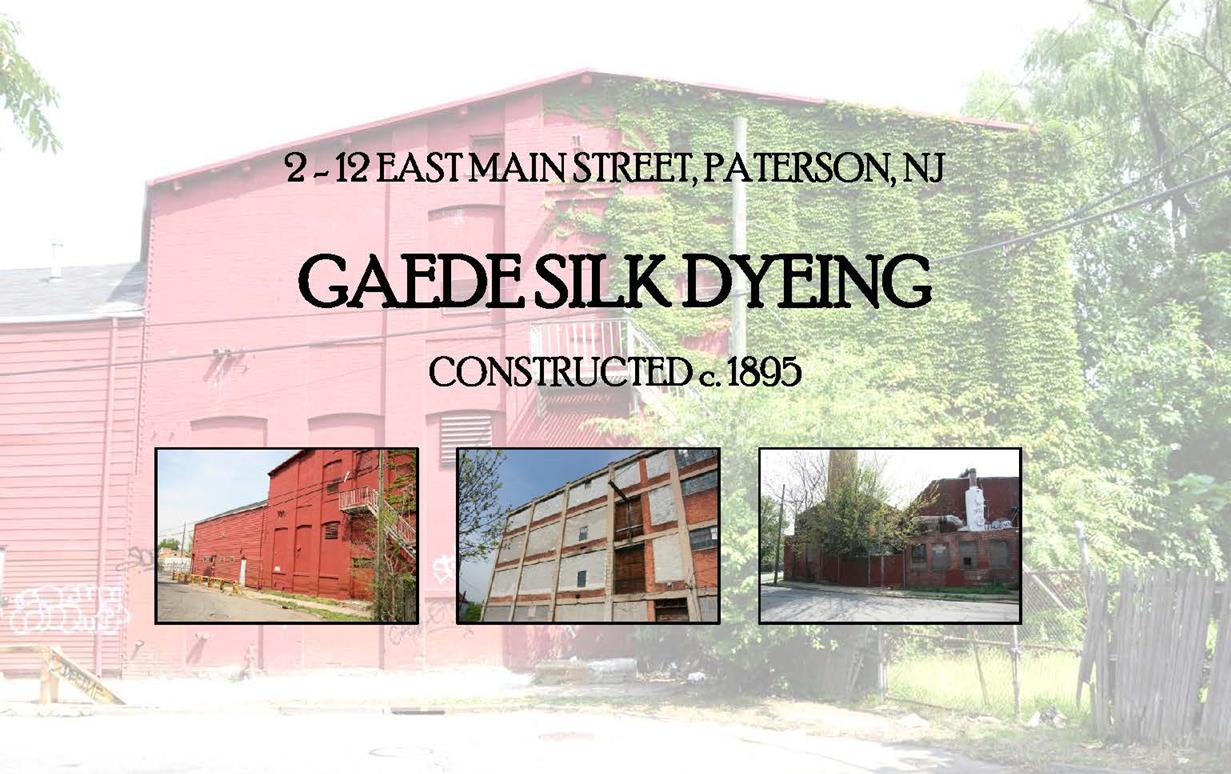
History
The Robert Gaede Silk Dyeing Works was established at this location in 1895 and operated under Gaede's management until being absorbed into the National Silk Dyeing Company conglomerate in 1908. Although Gaede's tenure at the site was relatively short, the works maintains the plan he established for the triangular-shaped lot, which was an advantageous location for a silk dye works due to its adjacency to the Passaic River as a source of water and to carry away waste.
Rober Gaede was among the leading silk dyers in Paterson, arriving in the city in 1880 from his native Driesen, Germany, where he had learned the trade as a young man. Gaede first found employment with Jacob Weidmann, but in 1883 set out on his own establishing a small shop at 24 West Street, and shortly outgrowing that shop relocating in partnership with John Allen, an English silk dyer, to a new and larger plant at Hamburg Avenue and Jane Street. Even this location eventually proved too confined, so in 1895 Gaede purchased the present property on East Main Street, which was not previously developed. This plant was built within the confines of the triangular lot with its long side oriented to the Passaic River and built atop a rubble masonry retaining wall that lined the river. By 1908, the works was employing about 150 men.
In 1908, Gaede was among the five Paterson dyers who merged to form the National Silk Dyeing Company. Under the new corporate structure, this plant became known as the East Main Street Works and was expanded into the lot on the west side of East Main Street. In 1914, Gaede withdrew from the management of National to start a new company with his sons William R. and Charles W. They established a new works on River Street and 4th Avenue, east of the New York, Susquehanna & Western Railroad bridge over the Passaic in the Riverside section of Paterson. This extensive plant was much larger than any of Gaede's earlier plants and was considered the most successful.
The former Gaede works at East Main Street remained under the National Silk Dyeing Company operation at least until the early to mid-1930s. By the 1950s, the old Gaede Works had changed hands and was under the control of the Art Silk Dyeing Co., which had its original works located at 65 North 9th Street.
Statement of Significance
The Gaede Silk Dyeing Company's works retains its original mid-1890s plan and massing, providing an important documentation of the scale and layout of dye works of the late 19th century. Particularly of interest is its orientation to the Passaic River, built atop a stone retaining wall, much as the early dye works at the ruined Allied Textile Printers site in the Great Falls district, upstream and across the river. There has been some diminishment in integrity, particularly infilled windows, but the 1-story, triangular-plan dye house is intact as is the 2-story finishing house. The frame ribbon shop and color storage shop, although having lost its fenestration, is a rare example of the type of ephermal small frame outbuildings that were once a common component of dye works and mill yards. The works is also associated with Robert Gaede, a prominent Paterson dyer who built up a successful family business through a succession of sites. This story has significance not only on an individual level but in illustrating one of the many patterns of business development that made Paterson a magnet for the silk-dyeing industry.
Hyde, E. B. Atlas of Passaic County, New Jersey, 1877.
Robinson, E. Atlas of the City of Paterson, New Jersey, 1884.
Robinson, E. Atlas of the City of Paterson and Haledon, New Jersey, 1899.
Mueller, A. H. Atlas of the City of Paterson, New Jersey, 1915.
Sanborn Map Company Insurance Maps of Paterson, New Jersey, 1915.
Sanborn Map Company Insurance Maps of Paterson, New Jersey, 1931.
Sanborn Map Company Insurance Maps of Paterson, New Jersey, 1950.
Heusser, Albert H. History of the Silk Dyeing Industry in the United States, 1927.
"Robert Gaede" [Obituary] in Silk, December 1926, p. 65, 1926.